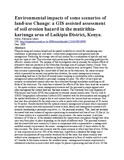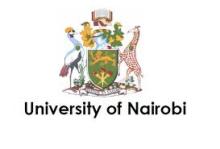Resource information
Characterizing soil erosion hazard and its spatial variability is critical for maintaining
user confidence in planning soil- and water- conservation programmes and general
land-use management. Predicting the average rates of soil erosion for a combination
of specific soil and land-use types is vital. This is because such predictions form a
basis for providing guidelines for effective erosion control.
The purpose of this investigation was to examine the erosion effects of alternative
land-use practices in the Mutirithia-Kariunga area of Laikipia District, Kenya. Four
different resource management systems or land-use scenarios were investigated.
These were the base scenario representing the current state of land use in the study
area, the maize scenario which represented an annual crop production situation, the
maize-management scenario representing land use in the form of annual maize
cropping in combination with a mulching management option and finally a perennial
cropping scenario. The effect of each land-use scenario on annualised erosion rates
was then examined through simulation modelling on all fields of the study area. The
study then evaluated the effects of the latter three land-use scenarios i.e. the maize
scenario, maize-management scenario and the perennial scenario against each other
and against the current land use; the base scenario. The Universal Soil Loss Equation
of Wischmeier and Smith (1978) was employed to estimate annual erosion rates. The
Arc Info & IDRISI Geographical Information Systems (GIS) assisted with the
determination and mapping of the spatial distribution of impacts due to soil erosion
from the various land-use scenarios. Soil loss was then calculated for the study area
in cells or pixels with a true ground-size of 50 meters by 50 meters.
Results showed that the optimal resource management scenario which minimized net
annual erosion rates and maximized returns to land, labour and management consisted
of a scenario maintaining a perennial crop cover, i.e., the perennial scenario. This
, land-use scenario decreased total area erosion of regions experiencing an annualised
soil loss of over 10 tlha yr', by 145 times relative to a representative annual crop
scenario - the maize scenario. A soil loss tolerance of 10 tlha yr', is the standard
established for conservation compliance though this value may vary from place to
place depending on the depth of different soils. The perennial scenario also
decreased total area erosion by 3 times in comparison with a representative
x
management modified annual crop scenario, the maize - management scenario and 13
times relative to the base scenario.
The worst-case scenario was the maize scenario in which soil loss of over 10 tlha yr'
was experienced on over 70% of the study area. Apart from a standard flat tillage and
a previous incorporation of crop residue treatment for all the cases, this maizescenario
was without extra management. On introducing land management in form
of residue mulch at a rate of 2 tonslha to this maize scenario, the resultant maize -
management scenario experienced a substantial reduction in areal extent with respect
to places experiencing soil loss of over 10 tlha yr', Such areas reduced in extent to
cover only 3% of the study area - a reduction of over 65%. This improvement is also
evidenced by a comparative "mere" 3 times that the soil loss in the maizemanagement
scenario was over the best-case perennial scenario. The planting of a
low bushy perennial crop reduced the annual soil loss from over 97% of the study
area to less than 5 tlha yr', Furthermore, only three percent of the study area
experienced soil losses above the five tonnes per hectare value in this perennial
scenario.
Vital implications for achieving and maintaining sound soil management practices
arise from the results of this study. The conclusions drawn from the study results
indicate that land-use with greatest negative impact on the study area with respect to
soil erosion is annual cropping with no soil conservation. However, investment in
land management techniques such as mulching substantially reduced the soil loss
from cropping land. A vegetative cover of perennials on the other hand also greatly
reduced erosion. The reduction of soil erosion rate therefore absolutely requires
improved management on both perennial and annual croplands. Erosion will only be
eventually reduced through improved levels of technology and increased technical
knowledge of the farmers. It is recommended that planners move in rapidly to
prioritise erosion protection measures on those areas that have been identified to
suffer extremely higher erosion and take remedial action before they are rendered
completely useless. Specifically this would entail, improved land use management,
strengthening of the Ministry of Agriculture extension activities, revision of district
wide development plans policies to reflect current and anticipated land use trends and
concerns of study area. This should be followed by educating the farmers of this area
on appropriate land management techniques using ongoing participatory planning
Xl
processes and developing public education and land use advocacy programmes, each
prescription being area specific due to differential rates of susceptibility to erosion.
On the other hand, the use of GIS tools to characterise annual soil loss potentially
offers great promise to expand quantitative databases. These tools provide
capabilities to provide vast information and knowledge to resource planners and land
managers in concise and informative map formats. The combined modelling and GIS
approaches allowed for rapid assessment of erosion hazard of the entire study area
with minimal data. This methodology was also flexible enough to rapidly simulate
different scenarios of land use, a feat that would take many years to achieve under
fieldwork conditions. The results of the study do not necessarily reflect the exact
amount of erosion that is occurring at specific sites of the study area but it does
provide planners with a guide showing areas that would require most attention from a
land management compliance standpoint. Much more confidence in the results would
only be achieved if consistent ground-truthing of the study results is undertaken. It is
recommended to scholars that validation of the model to this specific area is
necessary and would go a long way in developing models that can be used to
confidently and rapidly predict long-term soil loss relevant to this region. It is
specifically recommended that further research be conducted within an expanded
realm to encompass whole watersheds which will allow an understanding of region
level dynamics, that further spatial inventories of land and ecological resources be
undertaken and that much more accurate prediction models be built for this region and
be integrated with GIS.


